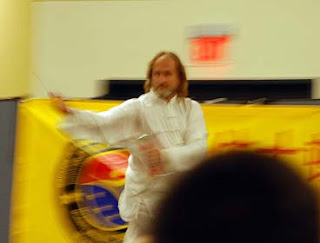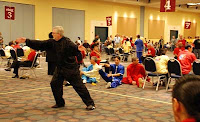although I did read a little more Friday and Saturday nights on Von Arnim's biography before going to bed, I was too tired to get much further.

The
Houston U.S. National Martial Arts Tournament was quite different from
Tai Chi Legacy in many ways. The scheduling was different because there were so many more young people competing in the internal arts...and what an eye-opener that was. Kids from 6 up were competing in tai chi, tai chi weapons, and baqua with a level of excellence that was inspiring. At the Legacy, most of the young people compete in Kung Fu and very few compete in the internal arts. Seeing some of these young people at the Houston Tournament competing in tai chi was a marvelous experience.
I've decided I should not be allowed to have a camera as the majority of the pictures I took were taken before realizing the camera was on the wrong setting. Almost the only decent pictures were taken by Thomas at the very end. :) which meant most of them were of me!
We got to the Stafford Center around 9:00 Sat. morning for the opening ceremonies and the dragons and several charming lions were great fun.

The Masters Demo was excellent--Thomas and I were impressed with so many of the performances (but almost none of my pictures turned out because they were on the wrong setting). Also, I couldn't stand up to get around all of the heads in my way...


I was able to get a couple of our sifu, Master Guerin by peering over heads, but they aren't very good shots. He was performing baqua with deer horn knives, and as usual got great audience response. Other performances that I particularly enjoyed were those by Kam Lee, King Lam, Blue Siytanco, and Phillip Luk, but every performance was a pleasure to watch and some of the Wu Shu young people took my breath away.
Our events didn't start until around 5:00 (no lunch, by the way), and we had no way of knowing that it would be such a long wait as we had never been to this tournament before. Thomas' events went first and followed in rapid succession with almost no time in between. He could barely keep up and change weapons before being called again. My events were much slower and the announcements changed our rings a couple of times, calling both Vivian and myself to one ring while we were awaiting our turns in another.

Thomas competed in empty hand, cane, saber, and straight sword and received gold in empty hand and silvers in each of the weapons. I was only able to take a couple of pictures before they began calling some of my events, even though the events didn't actually occur until much later.

I managed two golds (in empty hand and saber) and silvers in both

straight sword (Vivian beat me by a mile to take first place in straight sword) and in push hands (Vivian, a 98 lb. weakling, barely gave me time to catch my breath before throwing me off balance again! and again!). Look how tiny she is. One of the young men at our schools said of Vivian, "She looks like a delicate flower." And in her lovely pink uniform, she really does, but she's a tireless competitor and will be off to San Francisco to compete there next weekend.
It is always fun to see tournament friends like Connie and Charles from Gohring's School in Austin (and meeting and visiting with Maria from the same school) and Donna Minshew from Stan Rossi's Austin school. Other than judges, most of the tournament competitors were new faces for us.
I just decided to google Stan Rossi (since I didn't compete in 2006 and missed seeing him at the 2007 Tai Chi Legacy) ; I made a sad discovery.
Stan Rossi passed away last summer. What a loss--he was the kind of person whose spirit reached out to others. I had no real contact with Master Rossi except for watching him judge, but he was always so cheerful, warm, and good natured. Watching Master Rossi interact with the kids he was judging was a genuine pleasure as he always made them feel comfortable and secure. Whenever I saw him at a tournament, I smiled; I suspect that he affected a lot of people that way.
Judging is a tedious and, in many ways, thankless job, and maintaining good humor and concentration must be extremely difficult. Hours and hours and hours of watching and scoring competitor after competitor--with few breaks of any kind. Tournaments usually seem to run for more than 12 hours a day from opening ceremonies to final competitions. Judges travel from all over the country (and often from other countries) to tournament after tournament with little compensation other than lodging and meals, and then endure the grueling experience of sitting for 2 days judging the good, the bad, and the ugly in countless events. Hats off to all of them.























